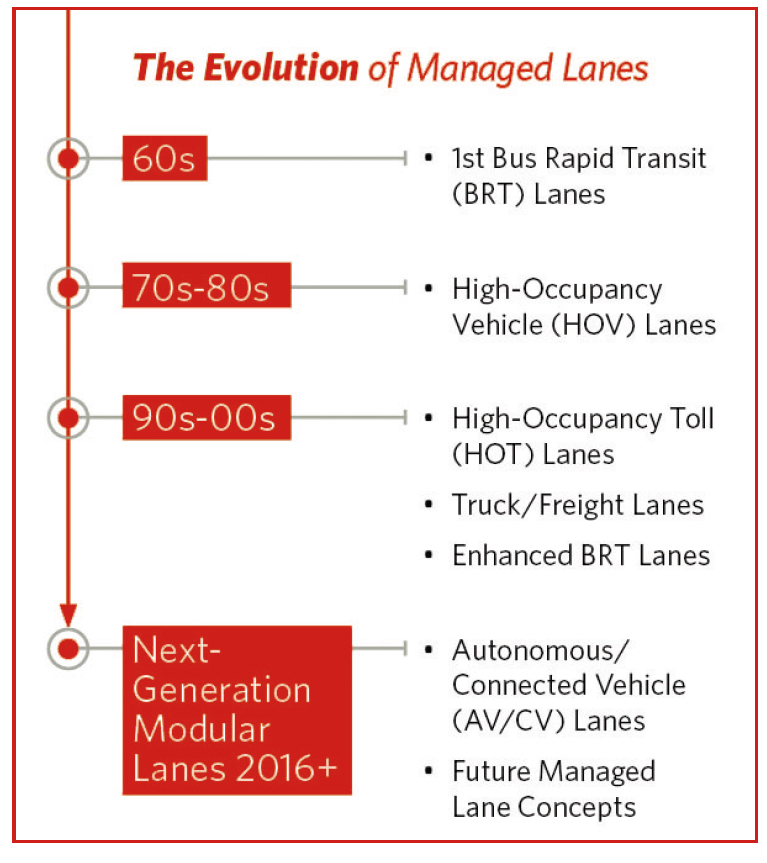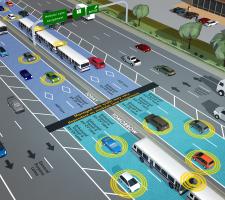
HDR consultants, Brian Swindell and Bernie Arseneau, consider managed lanes’ untapped potential.
It is no surprise that corridor planning continues to challenge agencies and owners as demand continues to surpass roadway capacity.
Planners are being asked to design roadways that will last for the typical 30-to 50-year design life, and the public expects that today’s infrastructure will be capable of addressing conditions that will arise in the future. Planners and designers are working diligently to capture the origin and destinations of key traffic movements and develop designs tailored to the land use and traffic movement along a corridor or region.
However, this is being done at a time when it is extremely difficult to develop long-term transportation strategies due to hard-topredict urban growth, shifts in land uses and technological advancements.
Increasingly, managed lanes are being employed to address congested corridors as agencies and owners look for new strategies to maximise their transportation investments. However, once designed and built, managed lanes and traditional roadways offer little flexibility to adjust without significant infrastructure re-investment. Going forward, adaptability will be essential in realising a full return on the investment of a newly-designed roadway well into the future. This is where the innovative concept and operation of managed lanes can provide options for future roadway planning and design.
Managed lanes are good at handling projected congestion, providing for reliable trips in the corridor and potentially recognising some revenue to offset project or operational costs. However, currently they are designed to solve a specific issue and are unlikely to provide the flexibility to adjust to the changing transportation system over time. That said, managed lanes are the most instrumented lanes in the network and the concept has yet to be fully explored to address the evolving needs and conditions as transportation continues to transform.
To that end,
Modular lanes are based on managed lanes but provide additional flexibility to adapt to the inevitable, but as yet not fully defined, changes that the transportation system will encounter over time. Modular lanes do not focus solely on a hardwired solution to a specific problem. They are ready to be adapted to new needs – be they autonomous and connected vehicles (AV/CV), changes in travel patterns or new land uses.
Designing for the unknown
While predicting future conditions is difficult, there is an opportunity to apply the knowledge and expertise gained from advanced design concepts, predictive modelling, current trends and technology to road design. This will not only enhance transportation systems and improve operations, it can ensure facilities won’t be obsolete from day one and can accommodate future technology.
The forward-thinking modular lane concept provides possibilities to accommodate AV/CV, enhanced transit, truck platooning and other innovative ideas to serve the travelling public. And, while managed lanes are a natural starting point because of their instrumentation, the modular lane concept could be extended to include the application to general-purpose lanes as the transportation system continues to evolve.
A primary feature of modular lanes is that they should maximise the use of current facilities while making sure planned facilities account for capacity to address future needs. To realise the full capability of modular lanes they need to work hand-inhand with active traffic management, ITS techniques and the new advancements that are developing every day. Another characteristic of the concept is that it can adjust the way lanes are utilised based on the real-time need in the corridor. Depending on the corridor, this adjustment can be one that is modified frequently or sporadically over time as needs and travel patterns shift Long-term changes could be implemented using existing technologies while daily conversions could utilise concepts such as in-pavement, dynamic lighted lane lines.
This approach, along with new technology and innovations, could be used in conjunction with one another or as a separate solution for particular applications. The purpose of this adaptable, flexible roadway concept is to create designs that take advantage of the anticipated advancements in transportation technology such as AV/CV and ITS applications.
Practical examples
Implementing modular lane principles provides numerous possibilities in both technological and design considerations. For example, a modular lane could easily be adjusted to accommodate directionality and adjust the number or designation of lanes. Other modifications that could be considered include:
- Adjusting the number and width of lanes to accommodate new and emerging vehicle types by using traditional lane re-striping or futuristic applications such as in-pavement, dynamic, LED technologies.
- Accommodating designated lanes that adjust over time. Today, that might include reversible configurations, high-occupancy vehicle (HOV) lanes and other approaches. In the future it could be platooning trucks and buses, AV/CV and shared ride concepts.
- Allowing for future in-pavement digital striping, buffer/separation technology that does not require a physical barrier and active traffic management/speed harmonisation technology that hasn’t even been conceived yet.
A more specific example might include a modular lane facility originally designed as two 3.6m (12ft) wide managed lanes which are subsequently adjusted to provide a designated AV/CV lane using in-pavement dynamic LED technology.
As traffic patternschange, the forward-thinking modular design would allow the road to be reconfigured as a three-lane facility. This could include two 2.4m (8ft) wide designated AV/CV lanes plus a slightly wider lane to accommodate truck and/or bus platooning with a shoulder that could be used as a drone pathway. Because these ideas were introduced early in the design life, all of this added capacity and flexibility could occur with no additional reconstruction or widening. Even further into the future, the lanes may be reassigned again to serve new technological applications and innovations.
Adaptable lane assignment could be used to separate automated vehicles from the general-purpose lanes. Over time, as the fleet transitions and the proportion of connected and autonomous vehicles grows, additional lanes could be allocated to AV/ CV use. Another option would be to make use of a dedicated transit lane and AV/ CV technology to provide platooned bus lanes. In this scenario, buses utilise fixed and limited headways that improve safety and reduce travel times while lowering fuel consumption and emissions. This enhanced transit configuration gives the rider the rapid transit benefits of light rail combined with the ‘last mile’ benefit of a bus network capable of delivering them closer to their ultimate destination without the need of a fixed guideway.
Long-term value
By definition, the modular lane concept is still evolving and will make use of the innovation and technology that is transforming the transportation industry. This paradigm shift in how roadways are planned and designed will enable agencies to be better prepared for future changes, realise better returns on their investments and make the most of the existing transportation infrastructure.
Knowing the impact that mobility has on economic growth, a cost-effective and expanded approach to improve the service, safety and sustainability of roadway networks is needed. That approach must embrace innovative concepts coupled with technologically-advanced system design and operational solutions that offer both short- and long-term value. The modular lane concept has great potential to meet operational needs and prepare agencies for the challenges ahead.
- ABOUT THE AUTHORS: Brian Swindell leads the Managed Lane Practice section of HDR’s Transportation Business Group. Bernie Arseneau is director of Traffic Management Systems, also within HDR’s Transportation Business Group.
Managed Lanes
The term ‘managed lane’ covers a broad range of applications including HOT (high-occupancy toll) lanes, transit-priority lanes, truck lanes and express/toll lanes.
They were first introduced in America in the 1960s and 1970s, largely serving transit purposes, and today they are an increasingly popular solution to manage congestion. With a new Moscow-St. Petersburg toll highway being built for the 2018 World Cup, Indonesia spending US$1bn developing its toll road network, and 195 nations supporting an agreement to reduce transportation-related carbon emissions, the interest in managed lanes is likely to grow.
Like a highway within a highway, managed lanes make use of existing or planned infrastructure to designate separate lanes that are actively managed through time of day, vehicle type, occupancy and/or congestion- level restrictions.
Key benefits of managed lanes
• Predictable travel times for peak hour commuters and transit ridership stimulus
• Congestion relief in general purpose lanes and/or arterials in the network
• Opportunity to introduce tolls to offset project costs, transit/freight advantage Results from managed lanes projects can be mixed and vary from project to project.
As congestion continues to increase, along with changing land uses, shifting travel patterns and rapidly evolving technology, transportation planners have to look for the next big evolutionary shift in corridor planning. New ideas need to build in flexibility for the future.













